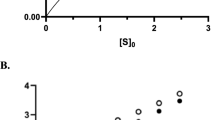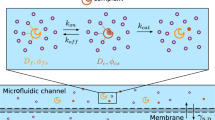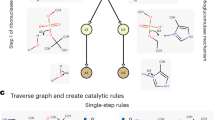Abstract
THE kinetic behaviour of most enzymes is more complicated than that described by Michaelis and Menten1 for the relatively simple mechanism: E + S = ES→E + P. Many enzymes have more than one substrate or product; others are inhibited by product and/or substrate, and their rate equations are correspondingly complex. For such enzymes, Michaelis–Menten kinetics are sometimes applicable at limiting conditions (such as velocities measured in the absence of product—that is, in zero time—using a large excess of all but one substrate), but this normally precludes any rigorous interpretation of the results. Oversimplifications of this kind have resulted in conflicting interpretations of the same data, leading to unnecessary controversy.
This is a preview of subscription content, access via your institution
Access options
Subscribe to this journal
Receive 51 print issues and online access
$199.00 per year
only $3.90 per issue
Buy this article
- Purchase on Springer Link
- Instant access to full article PDF
Prices may be subject to local taxes which are calculated during checkout
Similar content being viewed by others
References
Michaelis, L., and Menten, M. L., Biochem. Z., 49, 333 (1913).
Cleland, W. W., Biochim. Biophys. Acta, 67, 104 (1963).
King, E. L., and Altman, C., J. Phys. Chem., 60, 1375 (1956).
Author information
Authors and Affiliations
Rights and permissions
About this article
Cite this article
DAVISON, A. Mechanistic Interpretation of Empirical Enzyme Rate Equations. Nature 210, 1161–1162 (1966). https://doi.org/10.1038/2101161a0
Issue Date:
DOI: https://doi.org/10.1038/2101161a0
Comments
By submitting a comment you agree to abide by our Terms and Community Guidelines. If you find something abusive or that does not comply with our terms or guidelines please flag it as inappropriate.



